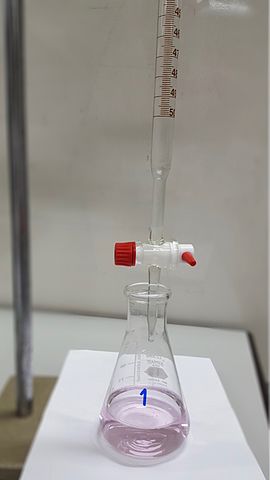Let’s say that a scientist carries out a titration. The titrant in the burette is 1M HCl and the analyte in the conical flask is 50cm3 of sodium hydroxide of an unknown concentration. The scientist wants to determine the concentration of the sodium hydroxide solution. The titration is carried out and it is determined that 27cm3 of hydrochloric acid are required to neutralise the solution.
Step 1: What reaction is occurring here?
HCl(aq) + NaOH(aq) → NaCl(aq) + H2O(l)
So the hydrochloric acid and the sodium hydroxide are reacting together in a 1:1 ratio (5 moles of HCl will react with 5 moles of NaOH).
Step 2: How many moles of the titrant were used?
Concentration(mol/dm3) = moles/volume(dm3), so moles = concentration(mol/dm3) x volume(dm3).
The volume of HCl was given in cm3; it needs to be in dm3.
27cm3/1000 = 0.027dm3.
Moles = 1mol/dm3 x 0.027dm3 = 0.027.
0.027 moles of HCl was used to neutralise the NaOH. Because of step 1, this means that the analyte also contained 0.027 moles of NaOH.
Step 3: What’s the concentration of the analyte?
Moles of NaOH: 0.027.
Volume of NaOH (from the start): 50cm3/1000 = 0.05dm3.
Concentration(mol/dm3) = moles/volume(dm3)
Concentration = 0.027 moles/0.05dm3 = 0.54mol/dm3.
The concentration of the sodium hydroxide solution is 0.54mol/dm3 (or 0.54M).
